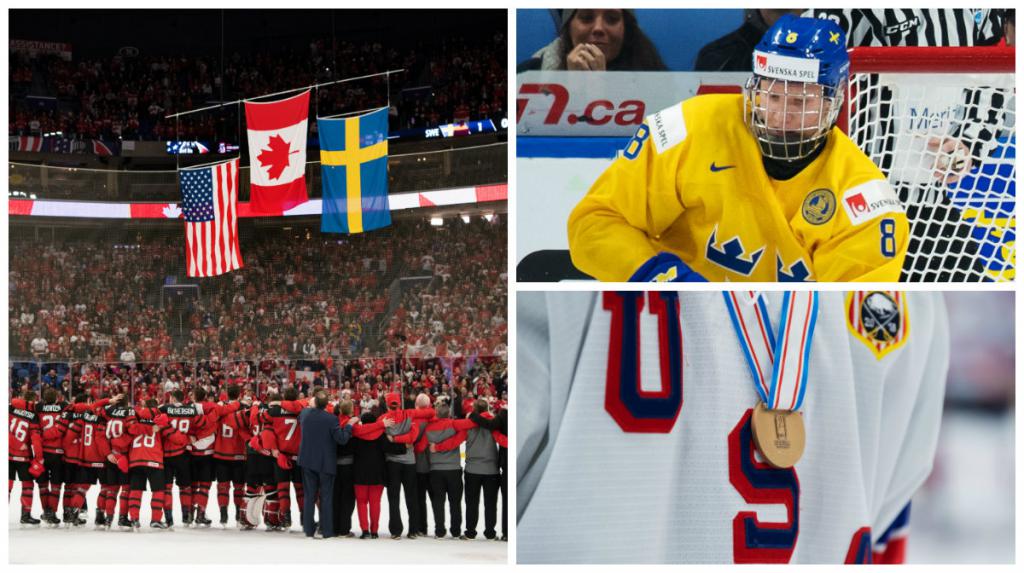The WJC summed up in seven thoughts

World Juniors 2018
2018-01-08, 18:49
- Rasmus Dahlin lived up to the hype: Since last June’s NHL draft, Rasmus Dahlin has been the face of 2018. For non-playoff teams in the NHL this season, Dahlin is the prize that’s said to have the potential to anchor a blueline for years to come. He proved he was worthy of the hype in Buffalo. Dahlin recorded six points in seven games in Sweden’s silver medal performance and logged mammoth minutes against the other teams’ top forwards. He looked smooth, poised, and confident with the puck and played responsibly in his own zone. Whoever’s lottery ball gets pulled come June is going to get themselves a damn good player.
- Other 2018 eligibles solidified themselves: It wasn’t just Dahlin who impressed at the WJC, though. Filip Zadina was named to the tournament’s all-star team after an eight-point performance that helped the Czech Republic reach the bronze medal game. Lesser-known Martin Kaut scored seven points in seven games and did a lot to boost his draft profile. Likely the best non-Dahlin performance for a 2018 draft eligible skater was Brady Tkachuk, who scored nine points in seven games for the United States playing with a gritty edge to his game. Based on their WJC performances, Tkachuk or Zadina may have jumped Andrei Svechnikov for No. 2 in the upcoming draft.
- Maybe Hockey Canada knows what they’re doing: Before the tournament, Canada was criticized for leaving players with high draft pedigree like Cody Glass, Michael Rasmussen, and Owen Tippett a home in favour of role players like Alex Formenton. It was expected Canada would have a difficult time scoring goals, but they ended up leading the group stage with 21 goals for, and, of course, they ultimately won gold with all forwards recording at least one goal.
- Sweden was probably the best team: The Swedes came up short against Canada in the gold medal game, but it’s hard to argue that they weren’t the best team in the tournament. Canada had seven power plays while Sweden only had one and Sweden managed to outshoot the Canadians regardless. Through the group stage, Sweden was dominant, scoring 20 goals and allowing only seven. They were lethal on the attack, managing to set up in the offensive zone quickly and create high quality chances out of nothing, and their defence was damn near unbreakable. It was the Swede’s first medal since 2014, and while not winning gold was disappointing, they should hold their heads high.
- The United States didn’t achieve their goal, but this is a golden age: The Americans were challenging to win a gold medal on home soil for the first time in tournament history, but they couldn’t get by a relentless Swedish squad in the semifinal. They pounded the Czech Republic in the bronze medal game and earned their third-straight medal at the WJC for the first time in tournament history. The program is in great shape and American hockey has never been stronger. Casey Mittelstadt earned tournament MVP after putting up 11 points in seven games and Kieffer Bellows broke an American record with nine goals in the tournament.
- Maybe ten teams is too many: Denmark and Belarus ended up in the relegation round to nobody’s surprise. Belarus fared better in the weaker group, going 0-4 but posting only a -10 goal differential while the Danes got pounded by Canada, the United States, and Finland, getting outscored 26-2 in four losses. With two bottom teams routinely getting pounded, the IIHF should consider going to eight games with a six-team playoff to maintain the a higher quality of games.
- Attendance woes are a black eye: There’s no way around it, this was a poorly attended tournament. Despite the United States having a very strong team led by a top Sabres prospect, fans in Buffalo weren’t all too interested in the games as KeyBank Arena was largely empty for all games other than the gold medal game when the city was infiltrated by Canadians. This tournament, especially the group stage, works better in smaller, Junior-sized arenas to create a more exciting atmosphere. It’s another thing for the IIHF and tournament organizers to consider, because filling NHL rinks for the World Juniors is a difficult endeavour, especially if you’re hosting it in a similar region in back-to-back years.
This article is about